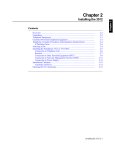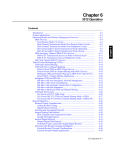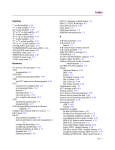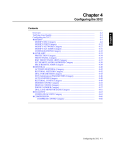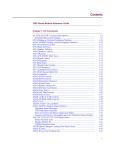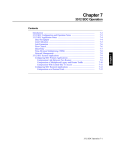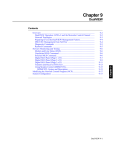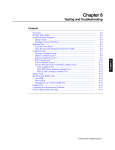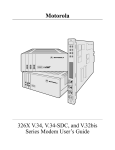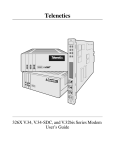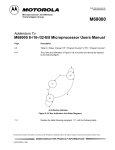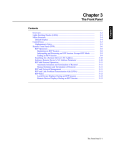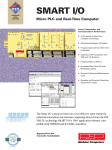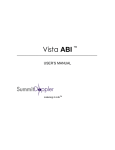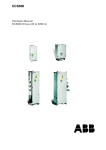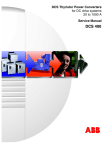Download Tran:3512 DSU/CSU User`s Manual:Chap1
Transcript
Introduction Contents Introduction .................................................................................................. Features.......................................................................................................... Operating Modes ...................................................................................... DDS-I Type Services ........................................................................... DDS-II Secondary Channel (SC) Type Services ................................. 64 kbps Clear Channel (64k CC) Service ............................................ Synchronous Data Compression (SDC) ................................................... DTE Ports ................................................................................................. Remote Front Panel (RFP) ....................................................................... Time Division Multiplexer (TDM) and Channel Sharing ........................ Multipoint Multiplexing (MP-Mux) ......................................................... Restoral Features ...................................................................................... Integral Restoral ....................................................................................... Integral Single Line Restoral (SLR) .................................................... Integral Digital Restoral (DDS or Switched-56) ................................. External (A/B) Restoral............................................................................. Dial Line Monitor (DLM) ........................................................................ Rate Adaptation ........................................................................................ Asynchronous-to-Synchronous Conversion ............................................. Circuit Quality Monitoring System (CQMS) ........................................... Tests .......................................................................................................... Network Management System and WANVisible ..................................... DualVIEW Management .......................................................................... Mini-Nest ................................................................................................. Compatibility ............................................................................................ 1-2 1-3 1-3 1-3 1-3 1-3 1-4 1-4 1-4 1-5 1-5 1-6 1-6 1-6 1-6 1-7 1-7 1-7 1-7 1-8 1-8 1-8 1-9 1-9 1-9 Introduction 1-1 Chapter 1 Chapter 1 Introduction This chapter describes the features of the Motorola 3512 Data Service Unit/ Channel Service Unit (DSU/CSU). Designed for connection to a digital network, the 3512 supports synchronous transmission up to 64 kbps and asynchronous transmission up to 19.2 kbps. The 3512 is also available with a bandwidth-expanding synchronous data compression (SDC) feature. The 3512 SDC supports point-to-point transmission of synchronous HDLC/SDLC-like framed data over DDS leased lines at up to 256 kbps. All 3512s function as “digital modems,” boosting signals across a four-wire leased line provided by an all-digital transmission facility that conforms to AT&T Publication 62310 and related Bellcore publications. Supported services include AT&T's DATAPHONE Digital Service (DDS and DDS Secondary Channel), ACCUNET Spectrum of Digital Services (ASDS), 64 kbps Clear Channel, and digital services from local exchange and interexchange carriers such as MCI and U.S. Sprint. Caution All 35XX devices, such as 3500s, 3512s, and 3520s, should be used in environments designed for computers and electronic equipment. In areas susceptible to lightning, take precautions to prevent damage to electronic equipment. Contact your telephone service provider, or an electronics accessories vendor, for information on lightning protection equipment. Customers experiencing problems due to surges from lightning have eliminated such problems by installing surge suppressors on power and data lines connected to 35XX devices. 1-2 Introduction Features The 3512 features Motorola's powerful 68HC000 microprocessor and Motorola's custom VLSI chips. The alphanumeric display and soft-touch controls allow for front panel operation of all functions. Password protection prevents inadvertent or unauthorized use of configuration, test, or remote functions. Error messages provide immediate notification of operator input errors and communication line faults. Any change to the 3512's selected configuration is automatically stored and retained when power is turned off or lost. Data protocols are transparent to the 3512; the 3512 SDC requires HDLC-like data. Four front-panel keys let you to configure and monitor 3512s in your network. You can run diagnostic tests on local and remote units. A remote 3512 is easily accessed using the Remote Front Panel (RFP) feature or network management. Operating synchronously or asynchronously, the 3512 delivers versatile, reliable, cost-effective data communications for your network. Operating Modes The 3512 operates with DDS-I and DDS-II SC type services at rates up to 56 kbps, and with Switched-56 kbps (SW 56), and 64 kbps Clear Channel (64K CC) services. DDS-I Type Services DDS-I and related services (including fractional T1 with DDS or generic digital access) support point-to-point and multipoint configurations at all operating rates. The level of network management and control depends on the network configuration and 3512 operating mode selected. DDS-II Secondary Channel (SC) Type Services With DDS-II SC type services, the local access circuit provides secondary channel bandwidth, in addition to the selected rate, for network management and control. DDS-II SC type services support point-to-point and multipoint operation at 2.4, 4.8, 9.6 and 19.2 kbps, and point-to-point operation at 56 kbps. 64 kbps Clear Channel (64k CC) Service 64k CC With 64k CC service, 3512s can pass data on point-to-point circuits at a line or port rate of 64 kbps. 64k CC supports network management in the non-interruptive modes (Bitstealing and Muxed). Introduction 1-3 Synchronous Data Compression (SDC) SDC 3512s with the synchronous data compression (SDC) feature offer the performance and reliability of the 3512, with transmission rates reaching 256 kbps. 3512 SDC devices offer bandwidth expansion to increase throughput over low-cost DDS-type leased lines. SDC devices: • Allow point-to-point transmission of synchronous HDLC/SDLC-like data • Provide faster file-transfer and response times • Use a modified version of the CCITT V.42 bis data compression algorithm with error detection and correction • Provide automatic anti-expansion to maintain high throughput of noncompressible data • Provide a migration path to higher-bandwidth applications • Support shared facilities for legacy and LAN-to-LAN applications, obviating the need for parallel networks • Offer compression on external (A/B) analog or digital switched circuits for restoral-mode operation • Offer compatibility with Motorola 326XFAST modems, for an ideal restoralpool product set • Offer integral Motorola leased line network management, providing continuous network operations visibility and control of critical links The 3512 SDC lets you lower your digital service costs. It provides optimum throughput for all HDLC/SDLC-like environments, such as Systems Networking Architecture (SNA), Statistical Multiplexer, and router networks. There is a special reference card to use with the 3512 SDC: 3512 SDC DSU/CSU Reference Card (Part No. 09831-5, Rev A). For SDC application examples, refer to Chapter 7, 3512 SDC Operation. DTE Ports The 3512 is available with one, two, or four physical DTE ports. The 3512 SDC is a three-port unit. Remote Front Panel (RFP) 3512s are equipped with Remote Front Panel (RFP), which enables you to view and set a remote device’s parameters from the local device. RFP includes escapeRFP mode, in which you can suspend an RFP session to check or adjust local parameters. For details on RFP, refer to Chapter 3, The Front Panel. 1-4 Introduction Time Division Multiplexer (TDM) and Channel Sharing Time-division multiplexing (TDM) and channel sharing (sometimes known as port sharing) features are available for the 3512. Channel sharing lets you map DTE ports to TDM channels; one or more ports share the bandwidth of a TDM channel. TDM and channel sharing operate together or separately, supporting data rates from 1.2 to 56 kbps (depending on line rate and operating mode). Each multiplexed port can buffer input data to accommodate internal and external clock differences, and can use the EIA 232-C/D or V.35 electrical interface. TDM is available as follows. These services... Support these configurations... DDS-I type Point-to-point, Multipoint DDS II SC type, 64k CC 3520 3512 Point-to-point And these features: Port-to-channel mapping; mixed TDM-channel sharing Port-to-channel mapping; mixed TDM-channel sharing NOTE: TDM and channel-sharing are compatible with other 35XX devices (such as 3500 or 3520 DSU/CSUs). Refer to Chapter 6, 3512 Operation, for details. Multipoint Multiplexing (MP-Mux) The MP-Mux feature supports a variety of capabilities. MP-Mux operates with DDS-I type services, at service rates of 9.6, 19.2, and 56 kbps. MP-MUX MP-Mux provides: • Multi-channel operation of multiple applications on one multipoint circuit • A non-disruptive network management channel over multipoint DDS-I type circuits in Bitstealing and Muxed operating modes. On a single 56 kbps channel, in addition to the network-management channels, the 3512 offers: — Bitstealing mode at up to 55.2 kbps — Muxed mode at up to 48 kbps for DTEs that require standard-rate clocks • Rate adaptation for multipoint applications, to allow DTE rates that are lower than line rates, and take advantage of attractive costs associated with higherspeed digital service. You avoid upgrade charges later, when you switch to higher speed DTE equipment. • Consolidation of multiple leased lines at a site onto one multipoint circuit, providing substantial line cost savings. For example, five 9.6 kbps point-topoint circuits terminating at remote locations can be consolidated on a single 56 kbps multipoint circuit. With an eight-port 3520 at the host site and one-port 3512s at up to eight remote sites, virtual point-to-point channels are established to each remote site over the 56 kbps multipoint circuit. • Automatic channel rate configuration of multiple slaves sent from the master device during the training sequence. For more information on... Configuring for MP-Mux operation Typical MP-Mux applications; and examples Refer to... Chapter 4, Configuring the 3512 Chapter 6, 3512 Operation Introduction 1-5 Restoral Features The 3512 offers internal (integral) and external (A/B) restoral, to resume operation in the event of primary-line failure. With integral restoral, you do not need an external device. Restoral can be initiated and terminated: • Manually, from the front panel • Manually, from a Motorola Network Management System (NMS) • Manually, from an IBM NetView • Manually, from a Novell WANVisible Network Manager • Automatically For more information on... Configuring for restoral operation Typical restoral applications; and examples Refer to... Chapter 4, Configuring the 3512 Chapter 6, 3512 Operation Integral Restoral Integral restoral can use an analog or digital line. With integral restoral, after returning transmission to the primary line, the 3512 can hold the restoral connection, and, if necessary, resume transmission on that line. This feature eliminates the need to redial and reestablish the restoral connection. Integral Single Line Restoral (SLR) SLR The integral Single Line Restoral (SLR) feature automatically restores data transmission over the analog Public Switched Telephone Network (PSTN). SLR complies with CCITT recommendations for V.32 and V.32 bis modulation modes. Implementing user-defined line failure parameters, the 3512 can dial up to four stored phone numbers, in a specified order. When a dial connection is established, it switches operation to that line. Operation can return to the primary line manually or automatically, also in accordance with user-defined parameters. Integral Digital Restoral (DDS or Switched-56) SW 56 The integral digital restoral feature uses DDS or four-wire Switched 56 (SW 56) service to automatically restore data transmission at rates up to 56 kbps. Implementing user-defined failure parameters, the 3512 can dial up to four stored phone numbers, in a specified order. When a SW 56 connection is established, it switches operation to that line. Operation can return to the primary line manually or automatically, in accordance with user-defined parameters. 1-6 Introduction External (A/B) Restoral The 3512 supports restoral to an external device (such as a Motorola 326XFAST Series Modem, or a 2-wire Switched Digital Data Service). On a multi-port 3512, Port 2 can route data to the restoral (B) device through its Line A-Line B (A/B) switch. Implementing user-defined failure parameters, the 3512 can signal an external restoral device to establish a dial connection, and switch operation to that line. Operation can return to the primary line manually or automatically, also in accordance with user-defined parameters. For more information on... Configuring for restoral operation Typical restoral applications; and examples Configuring 326X V.32 bis or 326XFAST modems as external (Line B) restoral devices Refer to... Chapter 4, Configuring the 3512 Chapter 6, 3512 Operation Chapter 6, 3512 Operation, Chapter 7, 3512 SDC Operation, The 3512 DSU/CSU Quick Start Dial Line Monitor (DLM) The dial-restoral line monitor (DLM) provides assurance that integral (switched analog or digital) restoral service will be available when you need it. You can set the monitor to test the alternate line once per hour or once per day; DLM generates an alarm and front-panel message if the line is not ready for use. Rate Adaptation Rate adaptation accommodates DTEs that use lower rates than the primary-line rate. It saves the expense of upgrading costly DTEs, and lets you take advantage of less expensive high-speed DDS lines. Rate adaptation is supported over point-topoint or multipoint DDS-I type circuits and point-to-point DDS-II SC type circuits. Asynchronous-to-Synchronous Conversion Integral asynchronous-to-synchronous conversion is standard and available on all channels. The async-to-sync converter, using the V.22 algorithm, accepts asynchronous data, converts the timing to match the synchronous DSU timing, and delivers the data with asynchronous timing. The converter operates with character lengths of 6, 7, 8, or 9 data/parity bits. Introduction 1-7 Circuit Quality Monitoring System (CQMS) The 3512 captures and displays comprehensive real-time network information to aid in anticipating problems and isolating faults. The Circuit Quality Monitoring System (CQMS) monitors major line parameters without disrupting data traffic. Front panel lights and displays provide immediate performance information. Knowledge of such properties as signal level and jitter help you identify line impairments, while the error-probability display provides a representation of line performance. With a network manager, CQMS reports alarms at the NMS if conditions deteriorate beyond established thresholds. Tests The 3512 incorporates a variety of tests to evaluate the local and remote unit: • Power-up Self-Test • Bit Error Rate • Terminal Loopback • Digital Loopback • Remote Loopback • DSU Check • Local Loopback • Pattern Tests • Service provider-initiated RT (DSU) Loopback • Service provider-initiated LL (CSU) Loopback • Service provider-initiated 64k Clear Channel Latching Loopback (LLB) Network Management System and WANVisible 3512s with the Network Management feature support comprehensive communication with a Motorola Network Management System (NMS)—such as the Motorola 9300 or 9800. From the NMS, you can configure local and remote 3512s, run reports, monitor alarms, and conduct trend analysis of any part of the network, without the need for remote personnel or manual logs. For more information on... Network Management feature Typical NMS applications; and examples Refer to... Chapter 4, Configuring the 3512 Chapter 6, 3512 Operation 3512s with Network Management also support a Novell WANVisible Network Manager. 1-8 Introduction DualVIEW Management DualVIEW Management enables control from IBM's NetView network management software, from a Motorola NMS (9300 or 9800), or both concurrently. Dualview can be purchased for 3512s and 3512 SDCs (for use only when the SDC device is not in Compress mode). DualVIEW does not operate with 64k CC service. DualVIEW management maps manager commands to 3512 parameters, using the Link Problem Determination Aid, Revision 2 (LPDA-2) protocol. In dual-management mode, the NMS is dominant and some restrictions apply to NetView. However, the NetView operator can monitor 3512 parameters and line status, and initiate 3512 tests. For more information on... The DualVIEW feature DualVIEW operation Refer to... Chapter 4, Configuring the 3512 Chapter 9, DualVIEW Mini-Nest The 3512 and 3512 SDC are available in standalone or Mini-Nest card module versions. Multiple modules may be compactly mounted in the Motorola Mini-Nest. You can remove standalone 3512s from their enclosures and put them in a MiniNest. (Consult your Motorola sales representative for conversion-kit ordering information.) Chapter 2, Installing the 3512, explains how to remove a 3512 from its enclosure. Standalone modules are compact—half-rack width—allowing two 3512s to be placed side by side in a Motorola rack-mount shelf. Compatibility 3520 3512 The 3512 is compatible with 3500 and 3520 DSU/CSUs, and, in SLR mode, with 326X devices, depending on the circuit configuration. For examples of circuit configurations that may benefit from mixing 3520s and 3512s, refer to Chapter 6, 3512 Operation. If you have the SLR, TDM, MP-Mux, or Network Management features, refer to Chapter 6 for interoperation considerations. SDC The 3512 SDC is compatible with other 3512 SDCs when in compress mode; and with other 35XX’s when not in compress mode. In SLR mode, the 3512 SDC is compatible with 326X devices, depending on the circuit configuration. Introduction 1-9 1-10 Introduction











